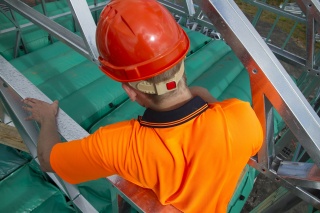Airmat soft fall technology to make construction sites safer
Building company owner David Grigor is aiming to significantly improve height safety work on construction sites by introducing Fall Safe airmat soft-fall technology to New Zealand.
Auckland-based Mr Grigor, owner of Grigor Construction Ltd, began researching soft-fall options to ensure his own worksites met the new Best Practice Guidelines for working at heights introduced by WorkSafe New Zealand.
 Now, having introduced the European Fall Safe modular airmat system to his own building projects, he is making the safety technology available for hire to other construction firms in New Zealand.
Now, having introduced the European Fall Safe modular airmat system to his own building projects, he is making the safety technology available for hire to other construction firms in New Zealand.
Under the new WorkSafe rules all construction sites must have fall arrest systems in place for anyone working at height.
“More construction companies are introducing soft fall options, which is good news,” said Mr Grigor. “However, most are opting to use nets, which are the cheapest option to purchase.
“I looked into using the nets but felt that there are a lot of risks associated with them and, when used in residential house construction in New Zealand, they usually don’t meet safety compliance standards.
“The most popular systems in Europe are the airmats and beanbags but the maximum height you can work above ground with beanbags as protection is 2.8m unless you double-stack them.
“After a lot of research I opted for the Fall Safe system which has been in use since 1998 and is compliant for people working at heights up to seven metres.”
Mr Grigor said that while the airmats are one of the most expensive safety systems to purchase, their long life expectancy makes them very affordable to hire and he now has 13,000sqm of them available for use in New Zealand.
“It struck me that if I was insisting on the safest possible soft-fall solution for my construction sites then other businesses would want that too,” he said.
“The airmats are a modular system of interconnecting mats linked together with a patented flexible Velcro system. They work through a reverse bouncy castle effect. Rather than people bouncing if they hit them, they are safely absorbed by a cushion effect, like a giant marshmallow.
“People can work at height above them with full confidence and they provide productivity gains because they are designed to absorb a ‘group fall’ of more than one person. This means a number of people can work at height at any one time. With nets the maximum permitted is two people.”
The system has been used in projects such as London’s new Wembley Stadium, and the London 2012 Olympic Park which set a new benchmark for health and safety throughout 62 million man hours of construction.
Statistics from the Health and Safety Executive (HSE), Britain’s national regulator for workplace health and safety, revealed that the accident frequency rate on site was 0.16 per 100,000 hours worked – lower than the all-industry average of 0.21 and significantly lower than the building industry average of 0.55.
Mr Grigor said he had concerns about the increasing use of nets as soft fall protection.
“In New Zealand most houses are timber braced and we work at much higher heights on trusses than other countries do,” he said. “All safety nets larger than 35sqm require a minimum of three metres of deflection – or drop. If someone falls from the plate of a building they are likely to hit the bracing, even with a net.”
Mr Grigor said all safety nets come under the guidelines of Fall Arrest Safety Equipment Training (FASET), the international trade association and training body for net rigging and fall arrest.
“FASET recommends that nets are attached to scaffolding structures all around the outside of the building,” he said. “However, that usually isn’t possible in New Zealand so they are being fixed to the wall heads of the building under construction instead, which is not compliant with FASET standards.”
Mr Grigor said additional potential problems included the difficulties of recovering an injured person from a net, workers unhooking the nets if they impeded their work or walking on them, potentially weakening them.
An estimated 200,000sqm of the Fall Safe airmats are now in use in the UK. As well as the construction industry they are used in a number of other industries and sports including aviation, to protect staff carrying out maintenance and repairs on the outside of planes, and in speedway providing ‘air curtains’ around tracks.



